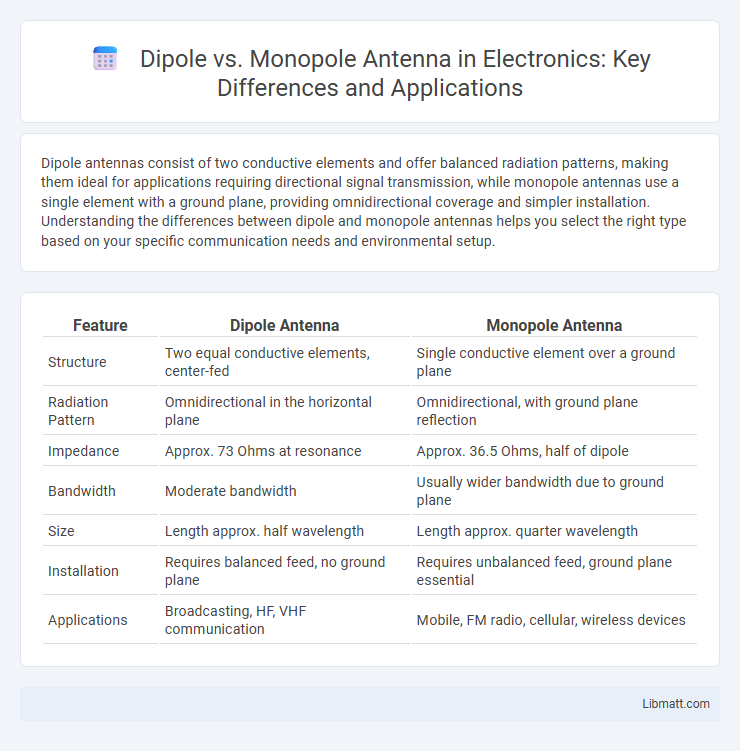Dipole antennas consist of two conductive elements and offer balanced radiation patterns, making them ideal for applications requiring directional signal transmission, while monopole antennas use a single element with a ground plane, providing omnidirectional coverage and simpler installation. Understanding the differences between dipole and monopole antennas helps you select the right type based on your specific communication needs and environmental setup.
Table of Comparison
| Feature | Dipole Antenna | Monopole Antenna |
|---|---|---|
| Structure | Two equal conductive elements, center-fed | Single conductive element over a ground plane |
| Radiation Pattern | Omnidirectional in the horizontal plane | Omnidirectional, with ground plane reflection |
| Impedance | Approx. 73 Ohms at resonance | Approx. 36.5 Ohms, half of dipole |
| Bandwidth | Moderate bandwidth | Usually wider bandwidth due to ground plane |
| Size | Length approx. half wavelength | Length approx. quarter wavelength |
| Installation | Requires balanced feed, no ground plane | Requires unbalanced feed, ground plane essential |
| Applications | Broadcasting, HF, VHF communication | Mobile, FM radio, cellular, wireless devices |
Introduction to Antenna Types
Dipole antennas consist of two conductive elements with equal length, typically half a wavelength, creating a balanced radiation pattern ideal for many communication systems. Monopole antennas use a single conductive element mounted above a ground plane, making them easier to install and often preferred for mobile and base station applications. The choice between dipole and monopole antennas depends on factors such as radiation pattern, installation environment, and system requirements for impedance matching and bandwidth.
What is a Monopole Antenna?
A monopole antenna is a type of radio antenna consisting of a single conductive element mounted perpendicularly over a conductive ground plane, which acts as a mirror to create an image antenna. It typically measures a quarter wavelength in length, making it smaller and easier to install than a dipole antenna. Monopole antennas are widely used in applications such as mobile communication, broadcasting, and radar systems due to their omnidirectional radiation pattern.
Understanding Dipole Antennas
Dipole antennas consist of two conductive elements that radiate radio frequency signals symmetrically, providing a balanced radiation pattern ideal for many communication applications. Their simple design offers optimal impedance matching and broad bandwidth, enhancing signal clarity and transmission efficiency for your wireless systems. Understanding the fundamental operation and practical advantages of dipole antennas helps improve antenna selection and network performance.
Construction and Design Differences
Dipole antennas consist of two conductive elements, typically metal rods, arranged symmetrically along a single axis, creating a center-fed structure that balances the antenna's electrical characteristics. Monopole antennas feature a single conductive element mounted perpendicularly above a conductive surface or ground plane, using this surface to mirror the antenna's image and effectively double its length electrically. Your choice between dipole and monopole designs depends on space constraints and the desired radiation pattern, as the dipole offers a bidirectional pattern while the monopole provides an omnidirectional pattern with simpler construction.
Operating Principles: Monopole vs Dipole
A monopole antenna operates as a quarter-wavelength conductor positioned perpendicular to a conductive ground plane, relying on image theory to create an effective radiating element equivalent to a half-wave dipole. In contrast, a dipole antenna consists of two quarter-wavelength conductive elements aligned end-to-end, directly radiating electromagnetic waves without the need for a ground plane. The monopole exhibits an omnidirectional radiation pattern in the horizontal plane, while the dipole produces a bidirectional pattern with nulls along the axis of the elements.
Radiation Patterns Compared
Dipole antennas exhibit a bidirectional radiation pattern with maximum gain perpendicular to the antenna wire, creating a figure-eight shape ideal for point-to-point communication. Monopole antennas produce an omnidirectional radiation pattern in the horizontal plane, radiating equally in all directions, which is suitable for broad coverage applications. The dipole's nulls occur along the axis of the element, while the monopole's ground plane acts as a reflector, enhancing radiation efficiency and pattern uniformity.
Typical Applications and Uses
Dipole antennas are commonly used in FM radio broadcasting, television receivers, and amateur radio due to their simple design and reliable omnidirectional radiation pattern. Monopole antennas are preferred in mobile communications, vehicle-mounted systems, and base stations for cellular networks because of their compact size and efficient ground plane utilization. Choosing between dipole and monopole antennas depends on your specific application requirements, such as frequency range and installation environment.
Performance Factors: Efficiency and Bandwidth
Dipole antennas typically offer higher efficiency and wider bandwidth compared to monopole antennas due to their balanced design and symmetrical radiation pattern. Monopole antennas, while compact and easier to ground, often exhibit narrower bandwidth and lower efficiency because they rely on a ground plane for signal reflection. Understanding Your application's performance requirements helps determine whether the dipole's superior efficiency and bandwidth or the monopole's simplicity better suit your communication needs.
Advantages and Disadvantages
Dipole antennas offer balanced radiation patterns and ease of impedance matching, making them ideal for wideband and versatile applications, but they require more physical space compared to monopoles. Monopole antennas are simpler, more compact, and often easier to install due to their single-element design, yet they depend on a ground plane for proper operation, which can limit performance consistency. The choice between dipole and monopole antennas hinges on factors like installation environment, frequency range, and desired radiation characteristics.
Choosing the Right Antenna for Your Needs
Selecting the right antenna depends on factors such as frequency range, radiation pattern, and physical size requirements. Dipole antennas offer balanced radiation and are ideal for applications needing omnidirectional patterns, while monopole antennas provide a ground-plane-dependent, efficient solution with a smaller form factor. Consider the operating environment and installation constraints to optimize signal strength and coverage for your specific application.
Dipole vs Monopole Antenna Infographic

 libmatt.com
libmatt.com